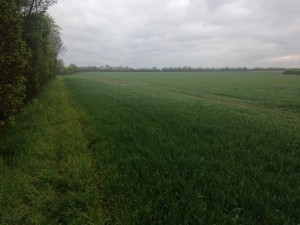
I was up early, although not that early for me, yesterday to visit one of my two Breeding Bird Survey squares. This is the 12th year I have covered this particular 1km square on the border of Cambs and Northants – it almost feels like mine after all this time.
The weather was cold, and it looked as though it might rain, but despite the nip in the air the visit went off fine. As I walked to the place where surveying starts, I noticed that the ground vegetation was very short – presumably because of the cold month of weather we have had (are still having!). Sometimes I am walking through knee-high grass at this stage, but not today.
It’s rather boring farmland with green lanes through it. But it’s also fascinating – simply because I am beginning to know it so well. The ‘star bird’ of this occasion was a Yellow Wagtail – which was also more or less the last bird I recorded. The numbers of Yellow Wags are declining nationally and have fallen over the years on this site too, and so every year I wonder whether I will see any. So far, every year I have; and that is now true of this year after Visit 1 (Visit 2 will be in early June). This bird was on a part of the route which has never before provided a Yellow Wag.
There were good numbers of Whitethroats and Yellowhammers, and record numbers (don’t get too excited – that is four) of Lesser Whitethroats too. And the second-ever Mistle Thrush. But no Reed Buntings – maybe next time.
As I sat at my computer to enter the data online, I learned later, a Common Crane was flying over my local patch of Stanwick Lakes. Hmm, the things I do for the BTO (and RSPB and JNCC).
[registration_form]
I cover three squares for BBS and can thoroughly recommend it. One is urban (right outside my front door, so great for early starts!) near Swansea, and one is in a village on Gower (lots to record in the village, but nearby farmland can be pretty dead).
But the ‘best’ is SN6907, in a valley above Swansea, which was counted for the 21st time since 1994 this year. Half is in farmland and a patch of upland woodland, whilst half is on upland pastures and a bit of rather degraded blanket bog. Over the years, it’s amassed list of 62 species. Nothing particularly rare, but it’s amazing what you find if you work away at a site for years.
Andrew – exactly! Birding with a purpose – and fun too.
Good on the BBS and all you observers. I ought to do it too…
Thanks for the eye catching bucolic landscape in your pic: straight lines, grudging footpath, three shades of green plus that NPK afterglow in the luxuriant wheat crop with its promise of one ton of beef raised from every eight tons grain per whatever.
And thanks for noting that parallel world that belongs to all of us: the unsubsidised soundscape that, if we are lucky, might have a Mistle Thrush giving out its poignant unfinished requiem of a song.
21 yeqrs and counting, good on yer.
We were probably out surveying at the same time Mark. My stars were two mistle thrushes and two swallows, neither of which I have recorded in my (just) three years on this patch in ‘call me Dave’s’ constituency.
Allen – very good, very good.